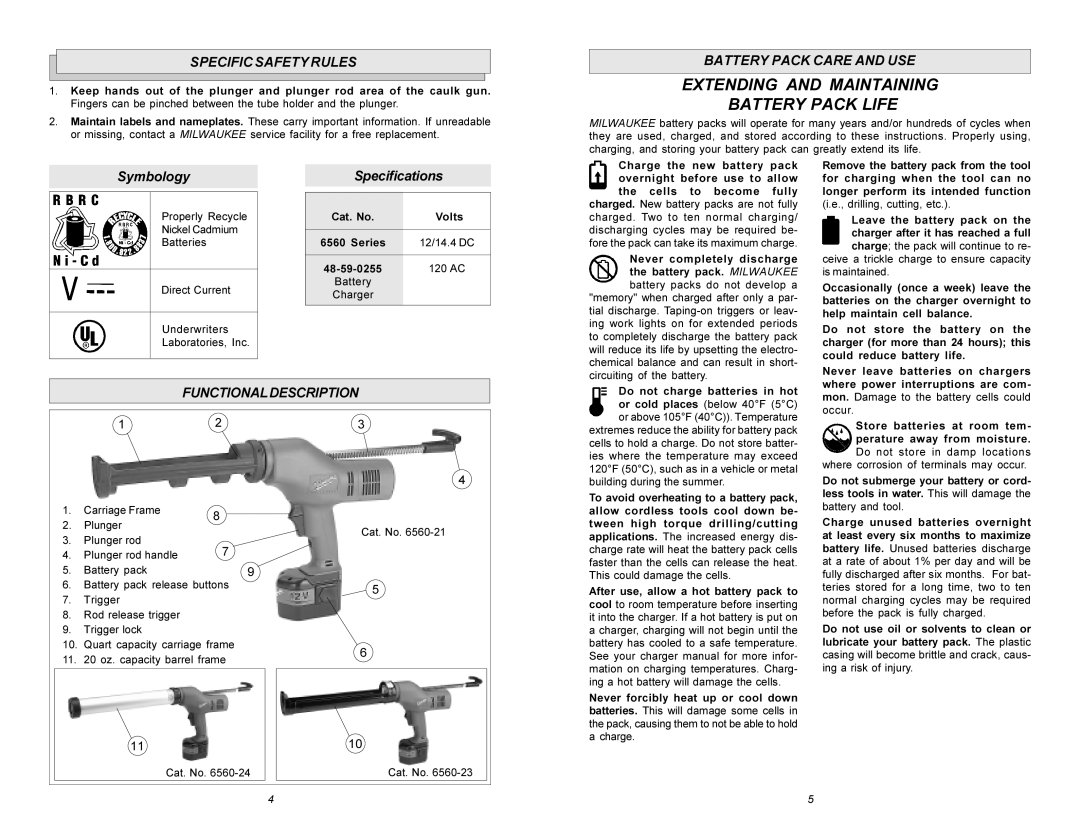
SPECIFIC SAFETY RULES
1.Keep hands out of the plunger and plunger rod area of the caulk gun. Fingers can be pinched between the tube holder and the plunger.
2.Maintain labels and nameplates. These carry important information. If unreadable or missing, contact a MILWAUKEE service facility for a free replacement.
BATTERY PACK CARE AND USE
EXTENDING AND MAINTAINING
BATTERY PACK LIFE
MILWAUKEE battery packs will operate for many years and/or hundreds of cycles when they are used, charged, and stored according to these instructions. Properly using, charging, and storing your battery pack can greatly extend its life.
Symbology
Properly Recycle
Nickel Cadmium
Batteries
Direct Current
Underwriters
Laboratories, Inc.
Specifications
Cat. No. | Volts |
|
|
6560 Series | 12/14.4 DC |
|
|
120 AC | |
Battery |
|
Charger |
|
|
|
Charge the new battery pack overnight before use to allow the cells to become fully
charged. New battery packs are not fully charged. Two to ten normal charging/ discharging cycles may be required be- fore the pack can take its maximum charge.
Never completely discharge the battery pack. MILWAUKEE battery packs do not develop a "memory" when charged after only a par- tial discharge.
circuiting of the battery.
Remove the battery pack from the tool for charging when the tool can no longer perform its intended function
(i.e., drilling, cutting, etc.).
Leave the battery pack on the charger after it has reached a full charge; the pack will continue to re- ceive a trickle charge to ensure capacity
is maintained.
Occasionally (once a week) leave the batteries on the charger overnight to help maintain cell balance.
Do not store the battery on the charger (for more than 24 hours); this could reduce battery life.
Never leave batteries on chargers where power interruptions are com-
FUNCTIONALDESCRIPTION
| 1 | 2 | 3 | |
|
|
| 4 | |
1. | Carriage Frame | 8 |
| |
2. | Plunger |
| ||
| Cat. No. | |||
3. | Plunger rod |
| ||
7 |
| |||
4. | Plunger rod handle |
| ||
5. | Battery pack | 9 |
| |
6. | Battery pack release buttons | 5 | ||
7. | Trigger |
| ||
|
| |||
8. | Rod release trigger |
|
| |
9. | Trigger lock |
|
| |
10. | Quart capacity carriage frame | 6 | ||
11. | 20 oz. capacity barrel frame | |||
| ||||
| 11 |
| 10 | |
| Cat. No. | Cat. No. | ||
Do not charge batteries in hot or cold places (below 40°F (5°C) or above 105°F (40°C)). Temperature
extremes reduce the ability for battery pack cells to hold a charge. Do not store batter- ies where the temperature may exceed 120°F (50°C), such as in a vehicle or metal building during the summer.
To avoid overheating to a battery pack, allow cordless tools cool down be- tween high torque drilling/cutting applications. The increased energy dis- charge rate will heat the battery pack cells faster than the cells can release the heat. This could damage the cells.
After use, allow a hot battery pack to cool to room temperature before inserting it into the charger. If a hot battery is put on a charger, charging will not begin until the battery has cooled to a safe temperature. See your charger manual for more infor- mation on charging temperatures. Charg- ing a hot battery will damage the cells.
Never forcibly heat up or cool down batteries. This will damage some cells in the pack, causing them to not be able to hold a charge.
mon. Damage to the battery cells could occur.
Store batteries at room tem- perature away from moisture.
Do not store in damp locations where corrosion of terminals may occur.
Do not submerge your battery or cord- less tools in water. This will damage the battery and tool.
Charge unused batteries overnight at least every six months to maximize battery life. Unused batteries discharge at a rate of about 1% per day and will be fully discharged after six months. For bat- teries stored for a long time, two to ten normal charging cycles may be required before the pack is fully charged.
Do not use oil or solvents to clean or lubricate your battery pack. The plastic casing will become brittle and crack, caus- ing a risk of injury.
4 |
5
